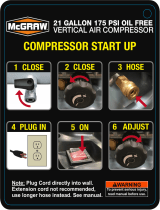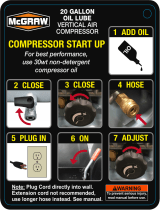
2
SAFETY RULES
1. Know your tool. Read this manual carefully.
Learn the tool’
s applications and limitations, as
well as specific potential hazards peculiar to it.
2. Ground all tools. If the tool is equipped with three-
pin plug, it should be plugged into a three-pin
electrical socket. Never remove the ground pin.
3. Avoid body contact with grounded surfaces such
as pipes, radiators, ranges, and refrigerators.
There is an increased risk of electric shock if
your body is grounded.
4. Do not expose tool to moisture. Don’t use this
tool in damp or wet locations. Keep out of rain.
5. Do not abuse cord. Never use the cord to carry
tools or pull the plug from an outlet. Keep cord
away from heat, sharp edges or moving parts.
Replace damaged cords immediately. Damaged
cords increase the risk of electric shock.
6. Remove adjusting keys or wrenches before
turning the tool on. A wrench or key that is left
attached to a moving part of the tool may result
in personal injury.
7. Keep work area clean and well lit. Cluttered or
dark work areas invite accidents.
8. Keep children away. All children should be kept
away from the work area. Never let a child
handle a tool without strict adult supervision.
9. Do not operate this tool if under the influence of
alcohol or drugs. Read warning labels on
prescriptions to determine if your judgment or
reflexes are impaired while taking drugs. If there
is any doubt, do not attempt to operate.
10. Use safety equipment. Eye protection should be
worn at all times when operating this tool. Use
ANSI approved safety glasses. Everyday
eyeglasses are NOT safety glasses. Dust mask,
non-skid safety shoes, hard hat, or hearing
protection should be used in appropriate
conditions.
1
1.
W
ear proper apparel. Loose clothing, gloves,
neckties, rings, bracelets, or other jewelry may
present a potential hazard when operating this
tool. Please keep all apparel clear of the tool.
12.
Don’t overreach. Keep proper footing and
balance at all times when operating this tool.
13.
Always disconnect the tool from power source
before making any adjustments, storing,
servicing, or changing accessories. Such
preventative safety measures reduce the risk of
starting the tool accidentally
.
14. Do not force tool. Use the correct tool for your
application. The correct tool will do the job better
and safer at the rate for which it was designed.
15. Do not use the tool if the switch does not turn it
on and off. Any tool that cannot be controlled with
the switch is dangerous and must be repaired.
16.
Check for damage. Check your tool regularly. If
part of the tool is damaged it should be carefully
inspected to make sure that it can perform its
intended function correctly. If in doubt, the part
should be repaired. Refer all servicing to a
qualified technician. Consult your dealer for advice.
17. Keep away from flammables. Do not attempt to
operate this tool near flammable materials or
combustibles. Failure to comply may cause
serious injury or death.
18. Store idle tools out of the reach of children and
untrained persons. Tools may be dangerous in
the hands of untrained users.
19. Maintain tools with care. Keep tools sharp and
clean. Properly maintained tools, with sharp
cutting edges, are less likely to bind and are
easier to control.
20. Never exceed the pressure rating of any
component in system.
21. Protect material and air lines from damage or
puncture. Keep hose and power cable away
from sharp objects, moisture, chemicals, oil, etc.
22. Check condition of hoses before each use. Do
not use a damaged hose. If hose is damaged,
replace immediately.
23. Read, understand and comply with all warning
labels on unit.
24. Drain tank of moisture after each use. If
Compressor is not to be used for extended
periods of time, leave tank drain valve open to
allow moisture to completely drain from tank.
25. Do not tamper with Safety Valve. The Safety
Valve is factory set for your model air
compressor. Any use adjustments to Safety
Valve will automatically void warranty.
26. Air compressors get hot while in operation.
NEVER touch the motor, discharge tubing or
compressor pump while in operation.
27. The Compressor operates automatically while
the motor is turned on.
28.
Compressed air from the unit may contain
carbon monoxide. Air produced is not suitable
for breathing purposes.
29.
Always use a respirator when spraying paint
or chemicals.
30. The air pressure switch is set at the factory for
optimum performance of your equipment. Never
attempt to bypass or remove this switch as
serious damage to equipment or personal injury
could result from excessive air pressure.













